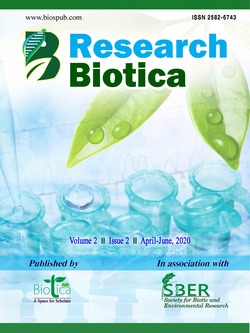
Field Evaluation of Different Insecticides against Blister Beetle, Mylabris pustulata (Thunberg) on Pigeon Pea
P. Thilagam*
Dept. of Agricultural Entomology, Tamil Nadu Agricultural University, Agricultural Research Station, Vellore, Tamil Nadu, India
D. Dinakaran
Dept. of Plant Pathology, Tamil Nadu Agricultural University, Agricultural Research Station, Vellore, Tamil Nadu, India
A. Gopikrishnan
Dept. of Plant Breeding and Genetics, Tamil Nadu Agricultural University, Agricultural Research Station, Vellore, Tamil Nadu, India
DOI: https://doi.org/10.54083/ResBio.2.2.2020.40-43
Keywords: Blister beetle, Field efficacy, Newer insecticides and Synthetic pyrethroids
Abstract
A field experiment was conducted during Kharif, 2018 to evaluate the efficacy of different insecticides against blister beetle, Mylabris pustulata (Thunberg) in pigeon pea. Among the seven treatments tested, Flubendiamide 480SC @ 30 g a.i ha-1 was found to be effective and recorded 2.67 and 3.56 numbers plant-1, respectively at 3 and 7 DAT after first spray followed by the treatment Indoxacarb 15.8SC @ 73 g a.i ha-1 which recorded 2.78 and 3.56 numbers plant-1. The third treatment proved to be effective was Deltamethrin 2.8EC @ 12.5 g a.i ha-1 with the population of 3.22 and 3.78 numbers plant-1. The similar trend of efficacy was noticed even after the second spray also. The order of efficacy of treatments in the population reduction of blister beetles was Flubendiamide 480SC @ 30 g a.i ha-1 > indoxacarb 15.8SC @ 73 g a.i ha-1 > Deltamethrin 2.8EC @ 12.5 g a.i ha-1 > Cypermethrin 25EC @ 25 g a.i ha-1 > Lambda cyhalothrin 5EC @ 25 g a.i ha-1 > NSKE 5%. As that of results on the efficacy of insecticides, the reduction per cent in the blister beetle population also follows the similar trend of different treatments tested. This effectiveness also reflected in the highest grain yield of 1140.20 kg ha-1 in Flubendiamide 480SC @ 30 g a.i ha-1 with a yield increase of 36.47% over untreated check. This was followed by indoxacarb 15.8SC @ 73 g a.i ha-1 (1102.3 kg ha-1) > Deltamethrin 2.8EC @ 12.5 g a.i ha-1 (1072.0 kg ha-1) > Cypermethrin 25EC @ 25 g a.i ha-1 (996.4 kg ha-1) > Lambda cyhalothrin 5EC @ 25 g a.i ha-1 (991.7 kg ha-1) > NSKE 5% (951.70 kg ha-1).
Downloads
not found
Reference
Blodgett, S.L., Denke, P.M., Knerr, V., 2010. Blister beetles of Montana. Montana State University Extension Service MT200209 AG, 100-210SA. pp. 1-4.
Dasbak, M.A., Echezona, B.C., Asiegbu, J.E., 2012. Field insect pests and crop damage assessment of pigeonpea (Cajanus cajan [L.] Huth) grown under ratoon and in mixture with maize. Chilean Journal of Agricultural Research 72(1), 45-52.
Deshmukh, S.G., Sureja, B.V., Jethva, D.M., Chatar, V.P., 2010. Field efficacy of different insecticides against Helicoverpa armigera (Hubner) infesting chickpea. Legume Research 33(4), 269-273.
Dhakla, K., Yadav, G.S., Rohilla, H.R., 2010. Incidence and flower damage of pigeonpea genotypes by blister beetle, Mylabris pustulata. Thunberg 23(3), 348-350.
Dikshit, A.K., Lal, O.P., Kumar, R., 2001. Persistence and bioefficacy of insecticides in okra and sponge gourd. Journal of the Entomological Research 25(2), 131-136.
Durairaj, C., 2000. A note on the host preference by two species of blister beetle in pulse crops. Madras Agricultural Journal 87(4/6), 355-356.
Durairaj, C., Ganathy, N., 1996. Identification of blister beetle complex on pigeonpea in Tamil Nadu, India. International Chickpea and Pigeonpea Newsletter 3, 96.
FAO, 2016. FAO Agricultural Statistical Database. Available at http://faostat.org/beta/en/#data. Accessed on: 20th November, 2016.
Gomez, K.A., Gomez, A.A., 1983. Statistical Procedures for Agricultural Research, 2nd Edition. A Wiley-interscience publication, New York, USA. p. 680.
Kemal, M., Kocak, A.O., 2008. Occurrence of two Epicauta species in Asia with some notes (Coleoptera, Meloidae). Cesa News 34, 1-4.
McBride, D.K., 2012. Blister Beetles. NDSU, Extension Service, www.ag.ndsu.edu, E-1002.
Mukherjee, I., Singh, R., Govil, J.N., 2010. Risk assessment of a synthetic pyrethroid, bifenthrin on pulses. Bulletin of Environmental Contamination and Toxicology 84, 294-300.
Pawar, K.S., Shende, S., Wadaskar, R.M., Thakare, A.Y., 2013. Studies on insecticide efficacy and application schedule for management of blister beetles on green gram. Journal of Food Legumes 26, 63-69.
Sarika, A.V., Iquebal, M.A., Rai, A., Kumar, D., 2013. PIPEMicroDB: Microsatellite database and primer generation tool for pigeonpea genome. Database 2013, bas054. DOI: 10.1093/database/bas054.
Shende, S., Thakare, A.Y., Wadaskar, R.M., 2013. Dose mortality responses of blister beetles against some insecticides. The Bioscan 8(3), 1061-1064.
Singh, A.K., 2017. Bioefficacy of different insecticides aginst blister beetle, Mylabris phalerata (Pallas) on pigeonpea. SAARC Journal of Agriculture 15(1), 55-65.
